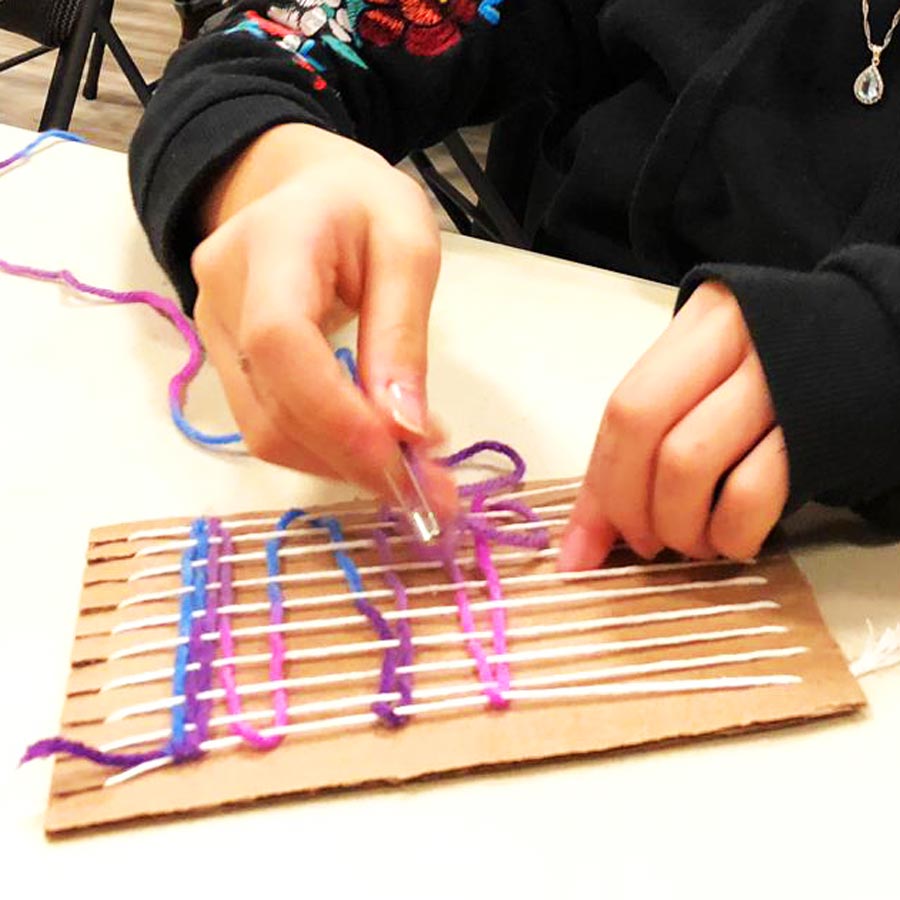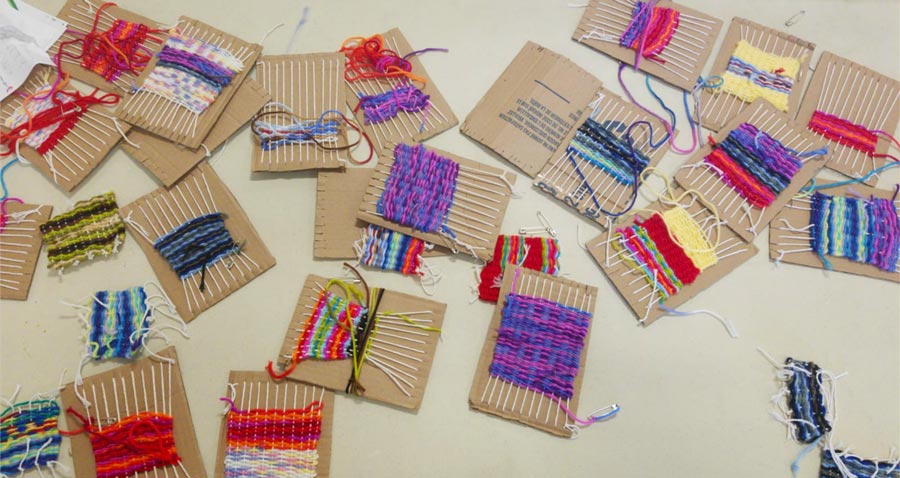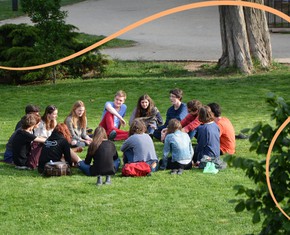The views expressed in our content reflect individual perspectives and do not represent the authoritative views of the Baha'i Faith.
Did you know that Abdu’l-Baha likens the concept of free will to that of a loom and weaver?
 I was recently reminded of this when I was asked to put together an art activity for some 50 Junior Youth aged 11-14, who were participating in a local Junior Youth camp over the Winter Break. The activity was part of a section in a book they were studying called Spirit of Faith, which is part of the Junior Youth Spiritual Empowerment Program curriculum. The aim of Spirit of Faith is to learn about the purpose of our existence as spiritual beings living in a material world. The story in Spirit of Faith follows a Junior Youth group and their animator, as they develop their understanding of the purpose of physical reality, in a spiritual and scientific way. Pretty profound and enlightening concept for a 12 year old don’t you think?
I was recently reminded of this when I was asked to put together an art activity for some 50 Junior Youth aged 11-14, who were participating in a local Junior Youth camp over the Winter Break. The activity was part of a section in a book they were studying called Spirit of Faith, which is part of the Junior Youth Spiritual Empowerment Program curriculum. The aim of Spirit of Faith is to learn about the purpose of our existence as spiritual beings living in a material world. The story in Spirit of Faith follows a Junior Youth group and their animator, as they develop their understanding of the purpose of physical reality, in a spiritual and scientific way. Pretty profound and enlightening concept for a 12 year old don’t you think?
The particular section they were studying starts off with an exploration of the word ‘fate’. Many of us believe that fate is something we cannot change. In a material sense we believe that fate is our divine design, our destiny, or an outcome that is handed to us. In some sense, these assumptions aren’t wrong, but it’s far more complex, and this is where the animator in the story, brings up the analogy of the loom and weaver.

In a talk given by Abdu’l-Baha, he shares that human life is like the loom, and our brains and body are the instrument with which the weaving is done:
The human soul is to be compared to a weaver; the human life is the thing woven, the cloth; the human body, principally the brain, is the tool, the instrument with which the weaving is done. – From a letter of March 1910 written by Dr. Josephina Fallscheer, addressed to Alice Schwarz-Solivo, recounting the responses given by Abdu’l-Baha during an interview conducted in Haifa, Israel during that same time period.
He goes on to say that God prepares the loom and the spaced threads that are stretched across the loom, called the warp. Abdu’l-Baha shares that the loom and warp are comprised of things handed to us that we cannot change, such as our parents, our ethnicity, the time and place we are born etc. The concept of free will lies within our volition to use the tools we are given by God, to develop our capacities and attributes. The tools, capacities and attributes we apply to our life are represented in the woof. The final design of the fibres, colours, textures in our weaving represent our life’s’ tapestry. This is our destiny, our fate, our free will:
God the Lord, the Master of the works, prepares the loom, that is the warp for the loom, the human milieu or environment with the ground–threads of fate. Thereby will be forced on the human being, the place, the time, the parents, the religion, nationality, society qualities, that is of gifted persons etc. The human soul then throws across the warp-threads the filling or woof by means of the shuttle that is the five senses, imagination, action, whereby up to the end of life as we say, are developed the masterpieces of the human life. – Abdu’l-Baha, Ibid
Abdu’l-Baha acknowledges that often times the soul cannot be choosy or limited by the materials it is endowed with. Nor can the human body be selective about the tools it has been given to work with. What we must understand is that our fate rests in the inherent talents, attributes, and powers we possess and apply to our weaving, no matter the tools or materials we are given. This, in the end, determines the results of our tapestry.
The materials for weaving may be of hemp-yarn, wool or silk, or some other mixture–which cannot be chosen by the soul, nor can the soul select the tools, but only the pattern and the method of weaving, insofar as it is not already predestined by the material itself to a certain degree. The material represents the inherited, (that is taken over) body organization. – Abdu’l-Baha, Ibid
Although God gives us different capacities, we’ve all been given what is necessary to develop as noble beings. We cannot blame God for our fate, as we’ve just learned, this is in our hands (quite literally). It’s in how we adapt and grow, with what we’ve been given. When we blame others on our shortcomings, we stunt the design of our destiny, our tapestry. What we can rely on is that we are constantly divinely protected and aided by God as He has laid the foundation for our lives, represented in the loom. The completed tapestry, as messy or as beautiful as it may be, is what we end up with at the end of our lives. Our fate or free will is symbolised by the intricacies, knots, loops, tangles and imperfections in our tapestry. They represent the ups and downs, moments of learning and growth.
The incomparable Creator hath created all men from one same substance, and hath exalted their reality above the rest of His creatures. Success or failure, gain or loss, must, therefore, depend upon man’s own exertions. The more he striveth, the greater will be his progress. – Baha’u’llah: Gleanings from the Writings of Baha’u’llah, pp. 81-82
If we compare our tapestry to those of others, we’ll always fall short, because no one is given the same tools and materials. We have to trust that we all have the capacity to make a beautiful tapestry in the eyes of God.
O my God! O my God! Thou seest me in my lowliness and weakness, occupied with the greatest undertaking, determined to raise Thy word among the masses and to spread Thy teachings among Thy peoples. How can I succeed unless Thou assist me with the breath of the Holy Spirit, help me to triumph by the hosts of Thy glorious kingdom, and shower upon me Thy confirmations, which alone can change a gnat into an eagle, a drop of water into rivers and seas, and an atom into lights and suns? O my Lord! Assist me with Thy triumphant and effective might, so that my tongue may utter Thy praises and attributes among all people and my soul overflow with the wine of Thy love and knowledge. Thou art the Omnipotent and the Doer of whatsoever Thou willest. – Abdu’l-Baha, Tablets of Divine Plan, p. 73
So together, with a lot of help from friends in the community, the Junior Youth studied this lesson at the camp in depth. In an attempt to assist them internalize this very profound concept, they applied this metaphor of Abdu’l-Baha’s to their own weaving project.
If you have a profound concept that you’ve explored through arts and crafts, particularly with Junior Youth, please leave a comment below! Or better yet, feel free to write about it and submit your article to [email protected]!
















Comments
Sign in or create an account
Continue with Googleor